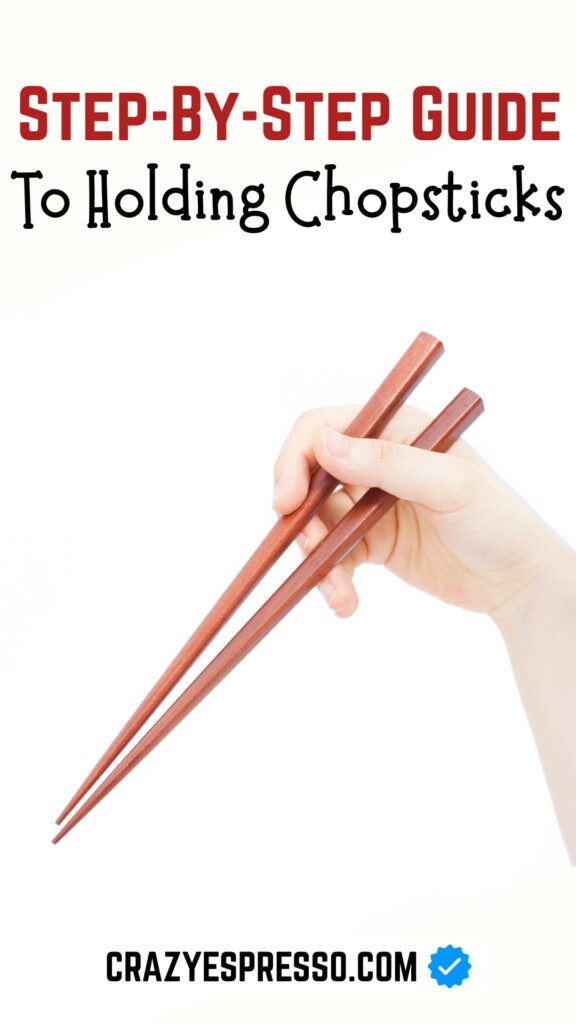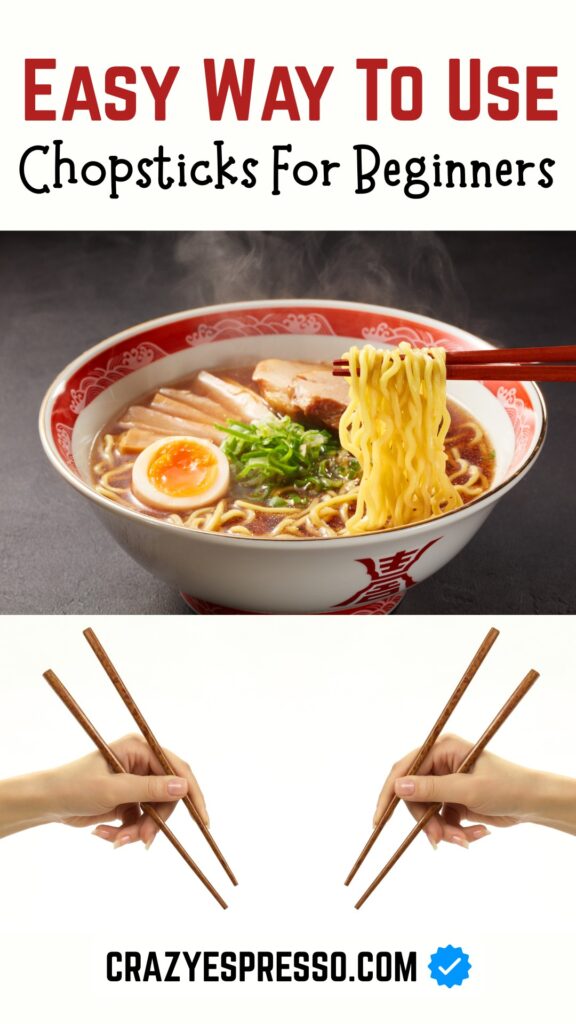If you’ve ever sat in front of a steaming bowl of noodles—whether it’s ramen, udon, chow mein, pad thai, or pho—you’ve probably wondered how people handle those smooth wooden sticks like it’s no big deal. Meanwhile, you’re there trying to grab a single noodle strand, and it keeps slipping away like it has a life of its own.
Honestly, using chopsticks looks intimidating from the outside… until you learn the trick behind them.
Once you get the hang of it, it actually feels natural—almost relaxing. And trust me, the moment you lift your first bite of noodles smoothly, you’ll feel like you’ve mastered a small life skill you didn’t know you needed.
This simple, friendly guide walks you through everything:
how to hold chopsticks, how to grip noodles properly, common mistakes, easy practice exercises, and even little techniques Asian diners use without thinking about it.
Let’s jump right in.

🍜 Why Learn to Use Chopsticks?
Before getting into the how-to, let’s be real—why even bother?
Well…
- It makes eating noodles way more fun
- It helps you enjoy Asian dishes the authentic way
- It improves hand coordination
- Many restaurants provide chopsticks by default
- It’s a unique skill that feels satisfying once mastered
Plus, people notice when you use chopsticks confidently. It shows effort, respect, and appreciation for the culture behind the food.
🥢 Step 1: Understanding the Chopstick Basics
Chopsticks may look like two identical sticks, but they don’t play the same role.
One stays steady—the other moves.
That’s the whole secret.
Here’s the breakdown:
✔ The bottom stick
- Acts like a support
- Rests between your thumb and ring finger
- Doesn’t move at all
✔ The top stick
- Held like a pencil
- Moves up and down
- Picks up the food
If you remember only this, you’re already halfway there.
✋ Step 2: Positioning Your Hand the Right Way
Holding chopsticks is all about comfort. If your hand feels stiff, you won’t be able to control them properly.
Let’s take it slowly.
1) Place the first chopstick
Hold your hand naturally—don’t tense up.
Now slide one chopstick between:
- The base of your thumb
- The side of your ring finger
Let it sit there comfortably. This lower stick is your anchor, so it shouldn’t wiggle.
If it’s moving around, reposition it gently until it feels stable.
2) Hold the second chopstick like a pencil
Pick up the second chopstick with:
- Thumb
- Index finger
- Middle finger
Just like how you hold a pen or pencil when writing.
This chopstick should feel lighter and more free.
3) Relax your grip
- Most beginners squeeze too hard.
- That’s why their hands get tired quickly.
- A gentle grip works better.
- Your chopsticks should feel secure but not stiff—like holding a feather, not a hammer.
💡 Step 3: Practice the Opening and Closing Movement
Before touching noodles, train your fingers to control the chopsticks.
✔ Keep the bottom stick steady
✔ Move only the top stick
✔ Open and close them like a claw
At first, the chopsticks may clack together or slip—don’t worry. It happens to everyone.
Try this simple drill:
Practice Exercise
- Tap the top chopstick up and down slowly
- Keep the bottom chopstick frozen
- Try opening them wide
- Then close them gently
- Repeat for 1–2 minutes
When the movement feels natural, you’re ready for noodles.
🍜 Step 4: How to Eat Noodles with Chopsticks — The Real Technique
Alright, now that you can hold chopsticks properly, here’s the fun part: eating noodles without making a mess.
1) Start by grabbing a small bunch
Don’t go for a big handful right away.
Instead:
- Lift a few noodles
- Make sure your chopsticks are gripping them firmly
- Avoid squeezing too tightly—no need to strangle the noodles
Imagine picking up a small ribbon. Same idea.
2) Lift the noodles slowly
- Noodles can be slippery. If you yank them up, they’ll fall or splash the broth everywhere.
- Lift gently, letting the extra strands hang.
3) Use the “support hand trick” (optional)
Many noodle lovers use their other hand to help guide long noodles.
You can:
- Hold a spoon under the noodles
- Catch extra strands
- Prevent dripping
It’s not cheating. It’s actually common.
4) Twist the noodles slightly
- A tiny twist helps the noodles clump together so they don’t fall apart.
Not a huge spin—just a small roll.
5) Bring the chopsticks toward your mouth
- Pull the noodles close.
- Lean in a little.
- Don’t try stretching your neck like a giraffe.
Eating noodles is supposed to be easy, not a workout.
6) Slurp (optional—but helpful)
- Slurping is normal in many Asian cultures, especially Japan.
- It helps cool the noodles and keeps them together.
If you feel shy, slurp softly.
Video Guide: How To Use Chopsticks
🥢 Tips to Make Eating Noodles Easier
Let’s make your chopstick journey smoother.
✔ Use wooden chopsticks, not metal
Metal ones are slippery and harder for beginners.
Wood or bamboo sticks give better grip.
✔ Hold them higher, not lower
People think holding them near the bottom gives more control, but it actually reduces movement.
A higher grip:
- Gives better leverage
- Makes it easier to lift noodles
- Feels more comfortable
✔ Let the noodles rest on the chopsticks
- Don’t rely only on squeezing.
- Half the support comes from resting the noodle bundle across the sticks.
✔ Don’t rush
- Eating noodles with chopsticks isn’t a speed contest.
- Slow, steady movements work best.
✔ Practice with dry noodles first
Soup noodles are slippery.
Start simple:
- Chow mein
- Stir-fried noodles
- Dry ramen
Then move to soupy bowls.
🧠 Common Chopstick Mistakes (and How to Fix Them)
If you’ve ever dropped food while using chopsticks, welcome to the club.
Here’s what goes wrong and how to fix it:
❌ Mistake 1: Both sticks move
If both chopsticks wiggle, you can’t grab anything.
Fix:
- Freeze the bottom stick like it’s glued.
- Focus only on moving the top one.
❌ Mistake 2: Holding them too tightly
This makes your hands tired and stiff.
Fix:
- Relax your fingers.
- Chopsticks work best with a soft grip.
❌ Mistake 3: Trying to lift too many noodles
Big bundles slip.
Fix:
- Pick up fewer strands.
- Small bites are easier.
❌ Mistake 4: Holding them too close to the tips
This gives you almost no control.
Fix: Hold them near the upper-middle area.
❌ Mistake 5: Fingers spaced too far apart
If your fingers stretch wide, chopsticks lose alignment.
Fix: Keep your hand compact and natural.
🏋️♂️ Easy Practice Drills to Improve Fast
If you want to get good quickly, try these fun mini-exercises:
1) Pick up small objects
Try foods like:
- Peanuts
- Beans
- Grapes
- Candy pieces
Great for building control.
2) Move items from one bowl to another
- Simple, but effective.
3) Pick up one noodle strand
- Yes—just one.
- If you can lift a single noodle without dropping it, you’re basically a chopstick master.
4) Lift food, hold it for 3 seconds, and put it down
- This strengthens stability.
🍜 How to Eat Different Noodle Types with Chopsticks
Not all noodles behave the same.
🥢 Ramen or Instant Noodles
- Scoop a small bunch
- Lift slowly
- Slurp lightly to avoid long dangling strands
🥢 Udon (Thick noodles)
- Thicker noodles are easier to grip.
- Use a slightly wider chopstick opening.
🥢 Soba
- They’re slippery—use a gentle scooping movement.
🥢 Chow Mein / Stir Fry
- The easiest noodles for beginners.
- Less slippage, more control.
🥢 Pho (Vietnamese noodles)
- Use the spoon-and-chopstick combo.
- It makes the whole process cleaner.
🍱 Extra Pro Tips to Look More Confident While Eating
Want to look like you’ve been using chopsticks for years?
✔ Lean slightly forward
✔ Keep elbows close to your body
✔ Don’t hold chopsticks too low
✔ Use slow, controlled movements
✔ Don’t stab food with chopsticks
Soon, your moves will feel natural and effortless.
🌟 Final Words: You’ve Got This
Learning chopsticks isn’t about perfection. It’s about patience. At first, the sticks may fall, cross, or slip.
Maybe your noodles dive back into the bowl with a splash. But every attempt gets a little smoother… and suddenly one day, it just “clicks.”
The moment you pick up a fluffy bunch of noodles and lift them with ease, you’ll know you’ve mastered it. So relax, practice a little, and enjoy the process. You’re closer than you think.


